I have seen 10 covers addressed to George Bruce over the past 2 years, and it has taken me all this time to come up with a coherent story about him. In the meantime, I had destroyed most of the scans. Recent covers have kindled my interest again, and my search led me to a researcher for Molong Historical Society and thence to Joan Marriott’s book The Crossroads. The History of Cumnock.
The first cover was registered with the red crossed lines and a manuscript ‘482′, it also had a manuscript ‘OHMS’ and was addressed to Geo Bruce Esq, Loombah, Yullundry. It has the mauve 6d NSW stamp with an ‘OS’ overprint, tied by the ‘15′ rays cancel and the Type 1D(i) cancel with MOLONG/ JU 2/ 1886/ N.S.W alongside. The arrival YULLUNDRY/ JU 22/1886 is of the Type 1A, described in the 2nd cover, and there is a purple double ringed oval ‘STOCK OFFICE/ MOLONG’ with a central manuscript ‘1.6.86′. The vendor states that according to Robson Lowe the ‘Molong #15′ cancel is rare, but I have seen no confirmation of this (Figure 1).
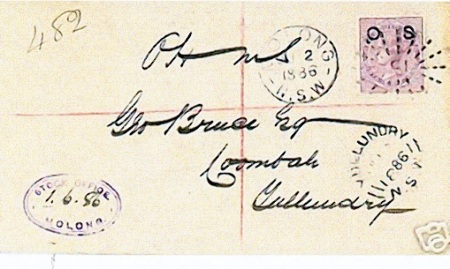
The second cover was addressed to Mr. George Bruce, Lombah (sic), Molong and the blue Two Pence NSW stamp was postmarked with a duplex SYDNEY AU 10/ 11–A.M/ 86/ 22 with the N.S.W obliterator. There was a transit postmark of YULLUNDRY/ AU 12/ 1898/ N.S.W, which was the incorrect year by 12 years. This cancel is the Type 1A which is unframed with double arcs on both sides, the date shown in 2 lines of removable slugs. The wrong date was achieved by the last 2 figures of the year slug being inverted and reversed! The Yullundry post office was 9 k north of Cumnock, it opened 1873 and closed 1887, and its only postmark, other than the numeral’681′, was the Type 1A from 1881-86 (Figure 2).
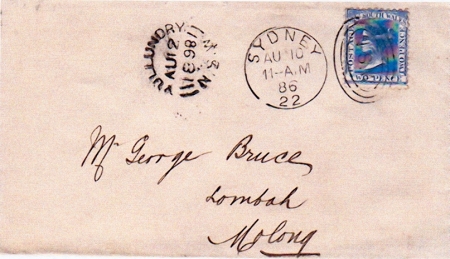
The third cover is addressed to George Bruce Esq, Loombah, Yullundry and it has a POSTAGE PAID SYDNEY/ MY 15/ 1-PM/ 95/ N.S.W postmark (Figure 3)
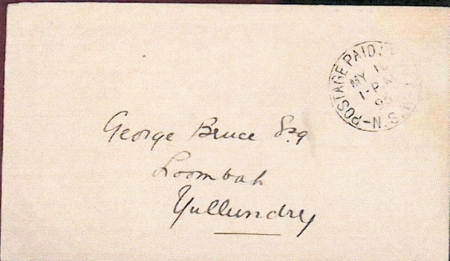
The fourth cover is addressed to George Bruce, Loombar (sic), Molong, N.S.W. and has an indistinct rays cancel on the blue TWO PENCE N.S.W. stamp and was sent from F.T. OGILVIE, Stock and Station Agent, Forbes, with a manuscript ‘Answered/ 16/1/83′ (Figure 4).
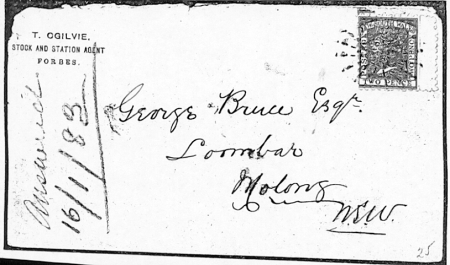
The reverse has the originating postmark of FORBES/ JA 12/ 1883/ N.S.W, a transit of ORANGE/ JA 12/ 1883/ N.S.W, a transit MOLONG/ JA 13/ 1883/ N.S.W (all three postmarks are Type 1D (i)) and the arrival Type 1A postmark at YULLUNDRY/ JA 13/ 1883 (Figure 5).
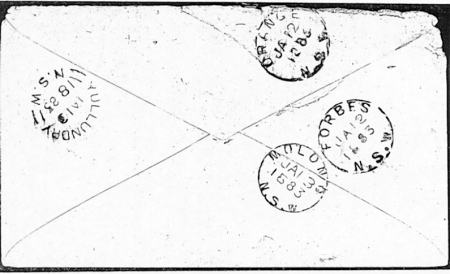
“When Scottish sailor, George Bruce, arrived at Sydney Cove in 1854, he literally jumped ship. The impetuous 23-year-old swam through shark-infested water to get to dry land, undeterred by the distance of the sinking transport, anchored several kilometres offshore.” His first job was gold digging at Hanging Rock near Tamworth and within months he moved on to Rocky River diggings, where he was the first to erect machinery for gold digging. Unsuccessful again at Tuena goldfields, he headed to Tamworth where he entered the employment of storekeeper, Hon. Francis Lord, on his Barrawang run at Cumnock.
For 16 years Bruce’s skill and knowledge of sheep husbandry, gleaned as a youth from his grandfather (Marcus Gunn, a renowned stock breeder at Rutter, Scotland), profited his absentee employer. By 1870 he had saved enough to purchase Loombah Station and he began sheep breeding on his own account. Loombah (derived from the Aboriginal word for steep banks) was the site where in 1879 the wool clip realised 16½ pence per pound, the best price obtained at that time for any clip in the colony. Loombah was to become famous for its wool quality, with buyers from France, England and Germany.
At the beginning of the Bruce era, Loombah covered 23,000 acres of purchased land and 8,000 acres of leasehold. It pastured 15,000 sheep as well as 200 head of cattle, 53 blood draught horses and also prize poultry. George Bruce married June Murray in 1857 and his two sons Sage and Robert carried on Loombah’s fine tradition. When George Bruce died on 12 January 1908 at the age of 76, Sage took over Loombah and its stud. George Bruce’s headstone in the Cumnock General Cemetery is seen in Figure 6.
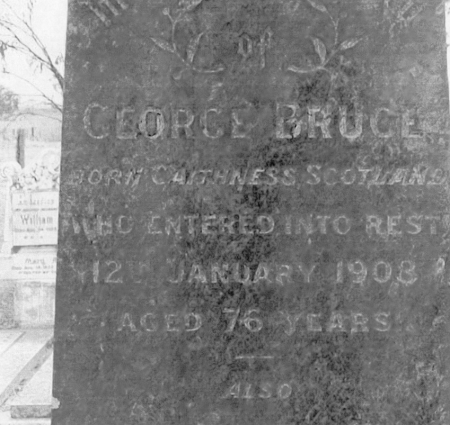
In 1924-25 the stud won the British Empire Exhibition award for the best fleece of ram’s wool, a record unmatched until recent times. George Bruce was also interested in breeding racehorses and he sold his stud progeny regularly at Sydney yearling sales.
A map of the region, including Cumnock, Molong and Orange, with the site of Yullundry highlighted with the blue arrow, is seen in Figure 7.
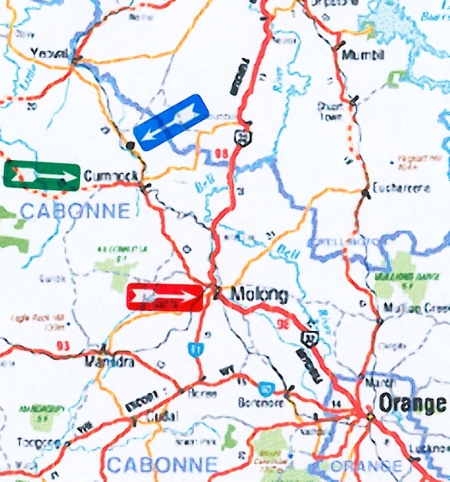
This paper would never have been written without the assistance of Catherine Mackenzie, Researcher for Molong Historical Society, and the text is taken from Joan Marriott’s book.
Addenda: More George Bruce! This cover was original sent to him at Byrock, N.S.W. and redirected to Loombah via Molong (Figure 8).
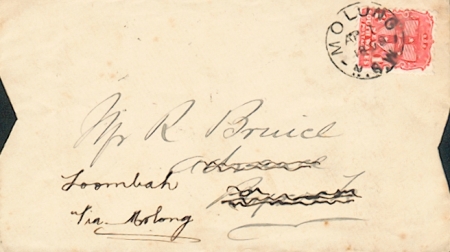
The reverse shows that it did go to Byrock, and lingered there for 2 days; the type 1D (i) postmark with the 7 mm arcs was the earliest recorded date, 1898. Note how the envelope was cut at both sides to show content, and allow the 1d rate for postage; it was addressed to R. Bruce who was George’s son, Robert Bruce (Figure 9).
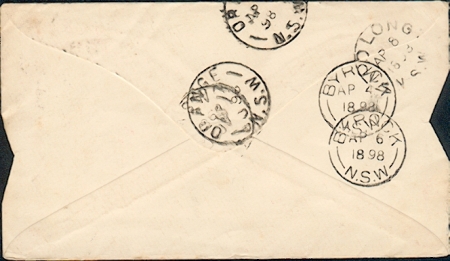
The next cover was addressed to another property, Burgoon, at Cumnock sent from The Exchange, N.S.W. , and the reverse not shown had no transit or aarrival postmark (Figure 10).
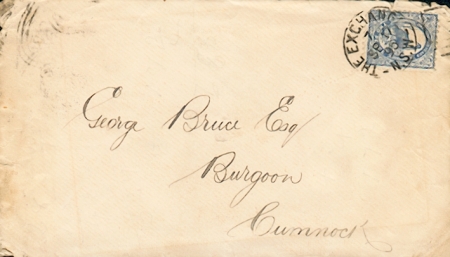
This cover was addressed to the property Loombah at Yullundry and has a fine Yullundry 1A postmark which only had usage for 6 years when the post office closed in 1887 (Figure 11).
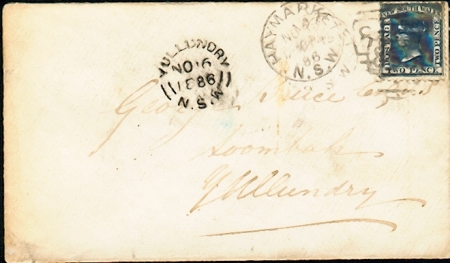
Yet another cover, but one addressed to his eldest son Sage Bruce, was posted with the blue 2d ‘Emu’ stamp postmarked with the numeral ‘1262’ of Byrock as will as the Type 1Di BYROCK/ MY 11/ 1896/ N.S.W. with the 2.5 mm arcs and addressed to the Glenroy property, Loombah, Molong (Figure 12).
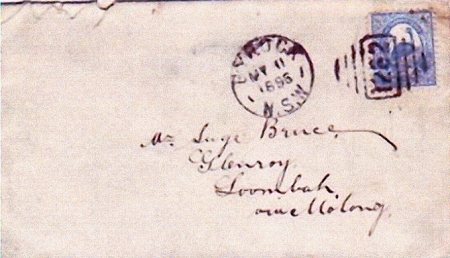
An abridged version of this paper has been published in the NSW Philatelist May 2007, Volume 29, pages 6- 10.